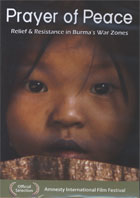
Prayer of Peace: Relief & Resistance in Burma’s War Zones 2007
Distributed by Choices, Inc., 3740 Overland Ave., Ste. F, Los Angeles CA 90034; (310) 839-1500
Produced by Matt Blauer
Directed by Matt Blauer
DVD, color, 28 min.
Jr. High - Adult
Asian Studies, Ethnic Studies, Human Rights, Sociology
Date Entered: 11/03/2009
Reviewed by Kayo Denda, Rutgers UniversityPrayer for Peace focuses on struggles experienced by the Karen, a minority ethnic group in Burma (Myanmar), enduring long standing discrimination from the Burmese majority. Although reports of the totalitarian Burmese junta and the house arrest of Aung San Suu Kyi are covered by the international media, Burmese internal ethnic struggles are far less known. The film captures Karen people and the enduring nomadic existence forced upon them by the Burmese Army’s extermination campaign and poses a set of questions about ethnic conflicts and internal displacement in Burma, bringing these issues to a broader audience.
The American filmmaker follows the group Free Burma Rangers (FBR) in its relief mission to provide the villagers food and medical assistance. Two members of the mission, Day Hoo, a nurse, and Monkey, a pastor/cameraman, offer examples of horrific moments in their lives and a powerful a sense of responsibility to care for their own people. In the case of Monkey, he expresses hope that testimonials from displaced Karen people will expose the international audience to the atrocity and human rights abuses by the Burmese Army, bringing support to end the ongoing conflict. The camera captures the devastation of burned villages, abandoned fields, and make-shift shacks with leaf covered roofs in refugee campus. With no regular access to health care, except for occasional FBR visits, some of the villagers who speak to the camera look visibly ill or disabled.
The film articulates an eloquent critique of the Burmese Army for the violence inflicted on the Karen people. However, it presents a very cursory treatment of resistance/militia activities. Groups such as Karen National Union and Karen National Liberation Army exist and actively recruit young prospects, engaging in full combat against the Burmese Army. It is also interesting that the FBR has a close relationship with the Fuller Theological Seminary, an evangelical Christian institution based in the United States. Some scenes of Karen people worshiping and Monkey’s account of his Christian faith have religious implications that remain unquestioned. In reality, all these groups most likely present a complex web of identities and political interests that remains unresolved in the documentary. It would have been more interesting to allow the Karen militia members to express their viewpoint and to treat Karen people not as victims, but as willful agents in a society plagued with conflicts. Nonetheless, the documentary serves as a starting point for productive discussions on ethnic conflicts and discrimination generally. It also serves as a vehicle to bring awareness to the oppression experienced by the Karen people.